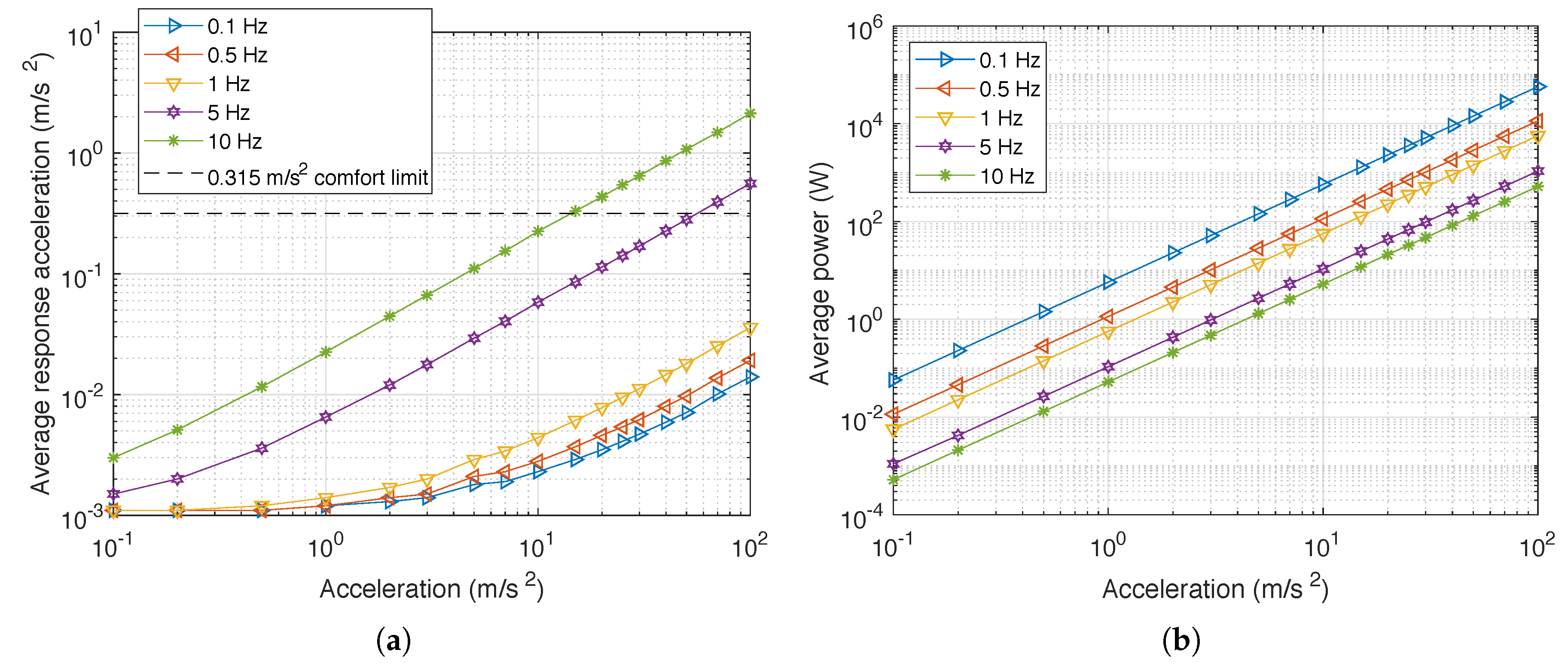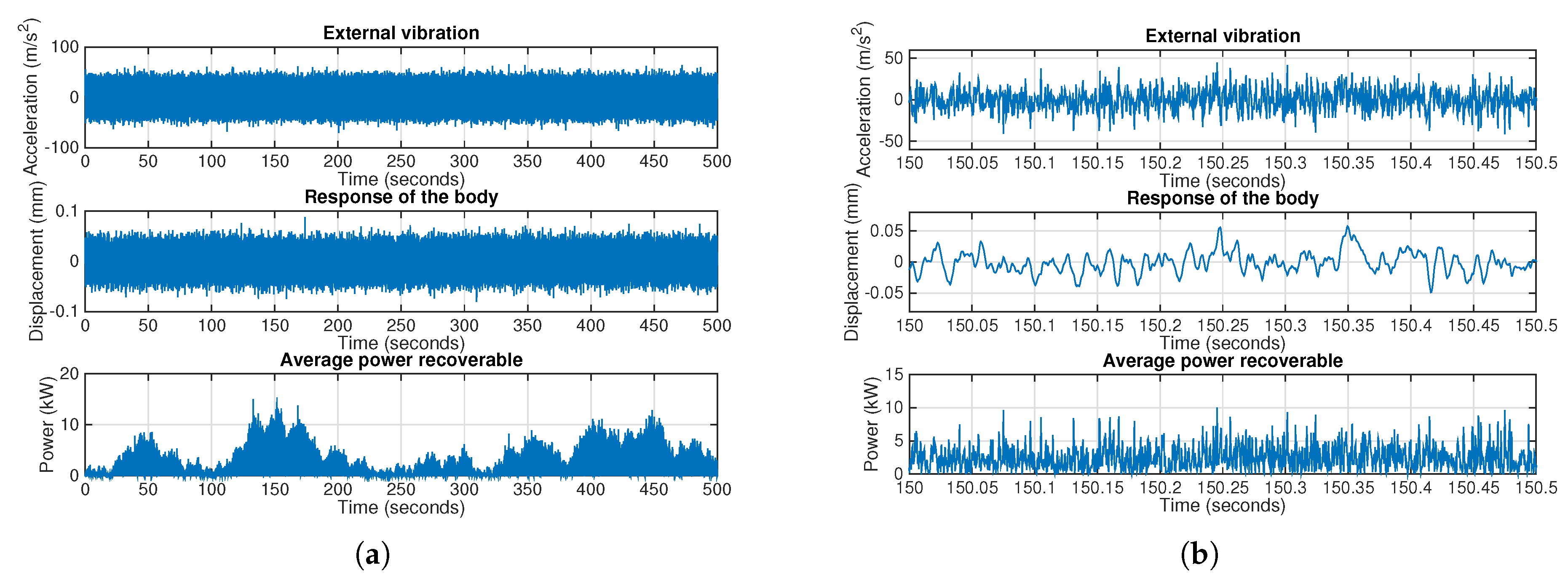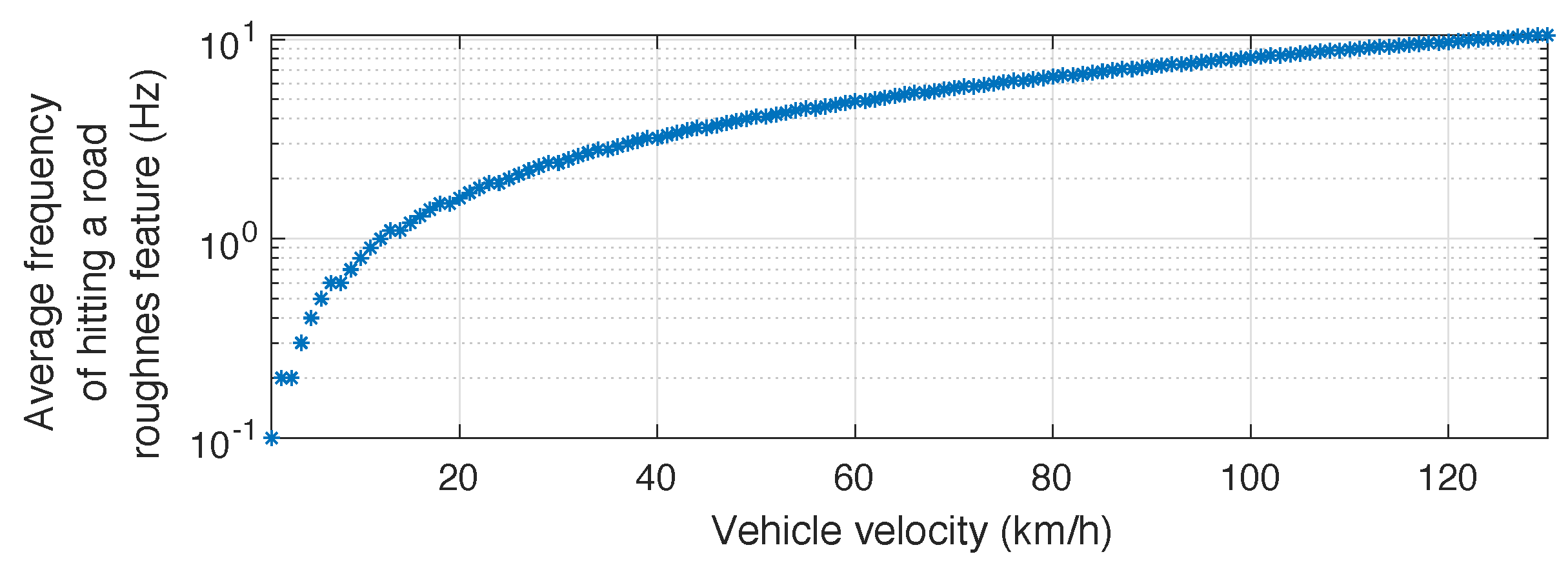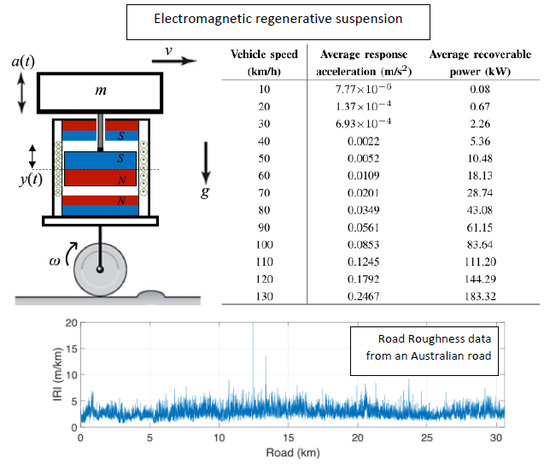An Analytical and Numerical Study of Magnetic Spring Suspension with Energy Recovery Capabilities
Abstract
:1. Introduction
2. Theory
2.1. Design
2.2. Analytical
3. Numerical Simulation
3.1. Method
3.2. Sinusoidal and Noise Simulation Results
3.3. Measured Road Condition Simulation Results
4. Discussion
5. Conclusions
Author Contributions
Funding
Acknowledgments
Conflicts of Interest
References
- Lightweigting Working Group. Lightweight Vehicles and Powertrain Structures: UK Opportunties; Technical Report; Automotive Council UK: London, UK, 2013. [Google Scholar]
- Ministery for Ecological and Inclusive Transition. Climate Plan; Technical Report; The French Government: Paris, France, 2017.
- Department for Environment, Food and Rurual Affairs, Department for Transport. UK Plan for Tackling Roadside Nitrogen Dioxide Concentrations; Technical Report; The UK Government: London, UK, 2017.
- A Nation With Ambition: The Government’s Programme for Scotland 2017-18; The Scottish Government: Edinburgh, UK, 2017.
- Pereirinha, P.G.; González, M.; Carrilero, I.; Anseán, D.; Alonso, J.; Viera, J.C. Main Trends and Challenges in Road Transportation Electrification. Transp. Res. Procedia 2018, 33, 235–242. [Google Scholar] [CrossRef]
- Pearre, N.S.; Kempton, W.; Guensler, R.L.; Elango, V.V. Electric vehicles: How much range is required for a day’s driving? Trans. Res. Part C Emerg. Technol. 2011, 19, 1171–1184. [Google Scholar] [CrossRef]
- Fuel Economy and Environment Label. Available online: https://www.epa.gov/greenvehicles/explaining-electric-plug-hybrid-electric-vehicles (accessed on 6 November 2018).
- Affanni, A.; Bellini, A.; Franceschini, G.; Guglielmi, P.; Tassoni, C. Battery choice and management for new-generation electric vehicles. IEEE Trans. Ind. Electron. 2005, 52, 1343–1349. [Google Scholar] [CrossRef]
- Tie, S.F.; Tan, C.W. A review of energy sources and energy management system in electric vehicles. Renew. Sustain. Energy Rev. 2013, 20, 82–102. [Google Scholar] [CrossRef]
- Hsu, P. Power recovery property of electrical active suspension systems. In Proceedings of the 31st Intersociety Energy Conversion Engineering Conference (IECEC 96), Washington, DC, USA, 11–16 August 1996; Volume 3, pp. 1899–1904. [Google Scholar] [CrossRef]
- Mapelli, F.; Sabbioni, E.; Tarsitano, D. Energy Recovering from Vibrations in Road Vehicle Suspensions; Springer: New York, NY, USA, 2011; pp. 67–75. [Google Scholar]
- Wang, R.; Tran, V.; Gu, F.; Ball, A. An investigation on energy recovery analysis of active suspension system. In Proceedings of the 19th International Conference on Automation and Computing, London, UK, 13–14 September 2013. [Google Scholar]
- Dineshkumar, R.; Elengovan, C.; Manivannan, P. Design and fabrication of magnet and spring suspension in bicycle. Int. J. Innov. Res. Sci. Eng. Technol. 2015, 4, 124–127. [Google Scholar]
- Xiao, Z.; Jing, X. Frequency-Domain Analysis and Design of Linear Feedback of Nonlinear Systems and Applications in Vehicle Suspensions. IEEE/ASME Trans. Mechatron. 2016, 21, 506–517. [Google Scholar] [CrossRef]
- Liu, J.; Li, X.; Wang, Z.; Zhang, Y. Modelling and Experimental Study on Active Energy-Regenerative Suspension Structure with Variable Universe Fuzzy PD Control. Shock Vib. 2016, 2016. [Google Scholar] [CrossRef]
- Cao, D.; Rakheja, S.; Su, C.Y. Roll- and pitch-plane coupled hydro-pneumatic suspension. Veh. Syst. Dyn. 2010, 48, 361–386. [Google Scholar] [CrossRef] [Green Version]
- Cao, D.; Song, X.; Ahmadian, M. Editors’perspectives: road vehicle suspension design, dynamics, and control. Veh. Syst. Dyn. 2011, 49, 3–28. [Google Scholar] [CrossRef]
- Xiao, Z.; Jing, X. An SIMO Nonlinear System Approach to Analysis and Design of Vehicle Suspensions. IEEE/ASME Trans. Mechatron. 2015, 20, 3098–3111. [Google Scholar] [CrossRef]
- Zuo, L.; Zhang, P.S. Energy Harvesting, Ride Comfort, and Road Handling of Regenerative Vehicle Suspensions. J. Vib. Acoust. 2013, 135. [Google Scholar] [CrossRef]
- Huang, B.; Hsieh, C.Y.; Golnaraghi, F.; Moallem, M. Development and optimization of an energy-regenerative suspension system under stochastic road excitation. J. Sound Vib. 2015, 357, 16–34. [Google Scholar] [CrossRef]
- Yan, S.; Sun, W. Self-powered suspension criterion and energy regeneration implementation scheme of motor-driven active suspension. Mech. Syst. Signal Process. 2017, 94, 297–311. [Google Scholar] [CrossRef]
- Xie, X.D.; Wang, Q. Energy harvesting from a vehicle suspension system. Energy 2015, 86, 385–392. [Google Scholar] [CrossRef]
- Sultoni, A.I.; Sutantra, I.N.; Pramono, A.S. Modeling, Prototyping and Testing of Regenerative Electromagnetic Shock Absorber. Appl. Mech. Mater. 2014, 493, 395–400. [Google Scholar] [CrossRef]
- Khoshnoud, F.; Zhang, Y.; Shimura, R.; Shahba, A.; Jin, G.; Pissanidis, G.; Chen, Y.K.; Silva, C.W.D. Energy Regeneration From Suspension Dynamic Modes and Self-Powered Actuation. IEEE/ASME Trans. Mechatron. 2015, 20, 2513–2524. [Google Scholar] [CrossRef]
- Guo, S.; Liu, Y.; Xu, L.; Guo, X.; Zuo, L. Performance evaluation and parameter sensitivity of energy-harvesting shock absorbers on different vehicles. Veh. Syst. Dyn. 2016, 54, 918–942. [Google Scholar] [CrossRef]
- Li, Z.; Zuo, L.; Luhrs, G.; Lin, L.; Qin, Y.-x. Electromagnetic Energy-Harvesting Shock Absorbers: Design, Modeling, and Road Tests. IEEE Trans. Veh. Technol. 2013, 62, 1065–1074. [Google Scholar] [CrossRef]
- Gysen, B.L.J.; Paulides, J.J.H.; Janssen, J.L.G.; Lomonova, E.A. Active Electromagnetic Suspension System for Improved Vehicle Dynamics. IEEE Trans. Veh. Technol. 2010, 59, 1156–1163. [Google Scholar] [CrossRef] [Green Version]
- van der Sande, T.P.J.; Gysen, B.L.J.; Besselink, I.J.M.; Paulides, J.J.H.; Lomonova, E.A.; Nijmeijer, H. Robust control of an electromagnetic active suspension system: Simulations and measurements. Mechatronics 2013, 23, 204–212. [Google Scholar] [CrossRef]
- Williams, C.; Yates, R. Analysis of a micro-electric generator for microsystems. Sens. Actuators A Phys. 1996, 52, 8–11. [Google Scholar] [CrossRef]
- International Organization for Standardization. Mechanical Vibration and Shock—Evaluation of Human Exposure to Whole-Body Vibration—Part 1: General Requirements; International Organization for Standardization: Geneva, Switzerland, 1997. [Google Scholar]
- Transport and Main Roads. Road System Condition—Roughness 1km. Available online: https://data.qld.gov.au/dataset/road-condition-roughness-data-and-class-1km-segments/resource/d618ce2e-7d29-4569-97bd-d97bd5831924 (accessed on 6 November 2018).
- Sayers, M.; Gillespie, T.; Paterson, W. Guide Lines for the Conduct and Calibration of Road Roughness Measurements; Technical Paper 46; World Bank: Washington, DC, USA, 1986. [Google Scholar]
- Elghriany, A.; Yi, P.; Liu, P.; Yu, Q. Investigation of the effect of pavement roughness on crash rates for rigid pavement. J. Trans. Saf. Secur. 2016, 8, 164–176. [Google Scholar] [CrossRef]
- Giuseppe, C.; Giuseppe, L. Road Roughness and Whole Body Vibration: Evaluation Tools and Comfort Limits. J. Trans. Eng. 2010, 136, 818–826. [Google Scholar]
- Department for Transport. Vehicle Speed Compliance (SPE01). Available online: https://www.gov.uk/government/statistical-data-sets/spe01-vehicle-speeds (accessed on 6 November 2018).













| Acceleration (m/s) | Comfort Level |
|---|---|
| < 0.315 | Comfortable |
| 0.315 < < 0.63 | A little uncomfortable |
| 0.50 < < 1.00 | Fairly uncomfortable |
| 0.80 < < 1.60 | Uncomfortable |
| 1.25 < < 2.50 | Very uncomfortable |
| > 2.00 | Extremely uncomfortable |
| IRI (m/km) | Example Road Type | Comment |
|---|---|---|
| <2.0 | Airport runway and highway | |
| 1.5–3.5 | New pavements | Surface imperfections |
| 2.5–6.0 | Old pavements | Minor depressions |
| 3.5–10.0 | Maintained unpaved roads | Frequent depressions |
| 4.0–11.0 | Damaged pavements | |
| 8.0–20.0 | Rough unpaved roads | Deep depressions |
| Vehicle Speed (km/h) | Average Response Acceleration (m/s) | Average Recoverable Power (kW) |
|---|---|---|
| 10 | 7.77 | 0.08 |
| 20 | 1.37 | 0.67 |
| 30 | 6.93 | 2.26 |
| 40 | 0.0022 | 5.36 |
| 50 | 0.0052 | 10.48 |
| 60 | 0.0109 | 18.13 |
| 70 | 0.0201 | 28.74 |
| 80 | 0.0349 | 43.08 |
| 90 | 0.0561 | 61.15 |
| 100 | 0.0853 | 83.64 |
| 110 | 0.1245 | 111.20 |
| 120 | 0.1792 | 144.29 |
| 130 | 0.2467 | 183.32 |
© 2018 by the authors. Licensee MDPI, Basel, Switzerland. This article is an open access article distributed under the terms and conditions of the Creative Commons Attribution (CC BY) license (http://creativecommons.org/licenses/by/4.0/).
Share and Cite
Jia, Y.; Li, S.; Shi, Y. An Analytical and Numerical Study of Magnetic Spring Suspension with Energy Recovery Capabilities. Energies 2018, 11, 3126. https://doi.org/10.3390/en11113126
Jia Y, Li S, Shi Y. An Analytical and Numerical Study of Magnetic Spring Suspension with Energy Recovery Capabilities. Energies. 2018; 11(11):3126. https://doi.org/10.3390/en11113126
Chicago/Turabian StyleJia, Yu, Shasha Li, and Yu Shi. 2018. "An Analytical and Numerical Study of Magnetic Spring Suspension with Energy Recovery Capabilities" Energies 11, no. 11: 3126. https://doi.org/10.3390/en11113126
APA StyleJia, Y., Li, S., & Shi, Y. (2018). An Analytical and Numerical Study of Magnetic Spring Suspension with Energy Recovery Capabilities. Energies, 11(11), 3126. https://doi.org/10.3390/en11113126






